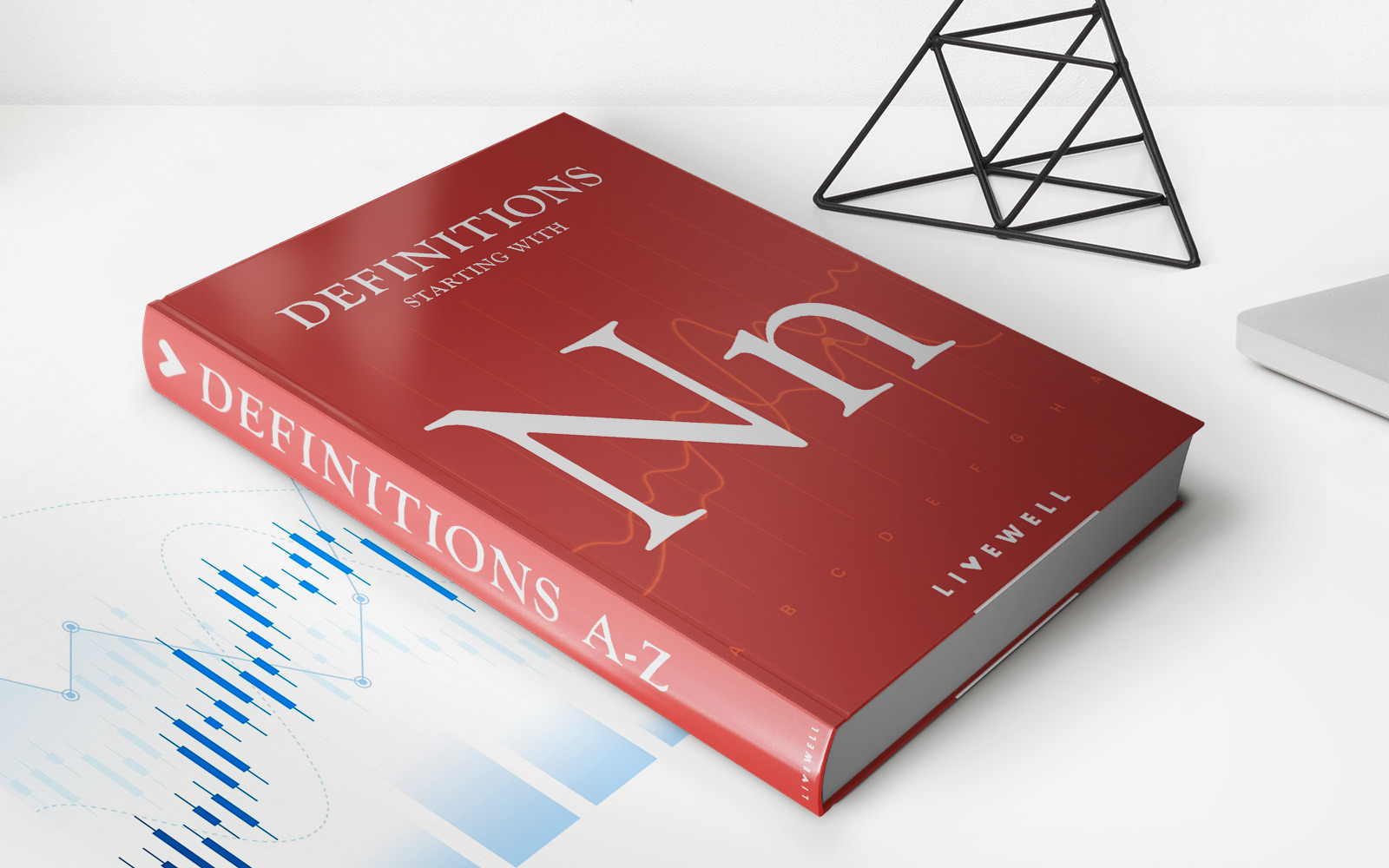Home>Finance>Which Risk Is Not Associated With Long-Term Negotiable Certificates Of Deposit?


Finance
Which Risk Is Not Associated With Long-Term Negotiable Certificates Of Deposit?
Modified: December 29, 2023
Find out the risk factors in finance by exploring which long-term negotiable certificates of deposit are not associated with any risks.
(Many of the links in this article redirect to a specific reviewed product. Your purchase of these products through affiliate links helps to generate commission for LiveWell, at no extra cost. Learn more)
Table of Contents
Introduction
Welcome to the world of long-term negotiable certificates of deposit (CDs), a financial instrument that offers investors the opportunity to earn steady returns over an extended period of time. As an SEO expert with deep knowledge in finance, I am excited to explore the intricacies of long-term negotiable CDs and shed light on the risks associated with them.
Before we dive into the potential risks, let’s take a moment to understand the basics. Long-term negotiable CDs are a type of fixed-income investment issued by banks, financial institutions, and credit unions. These CDs have a maturity term of more than one year, usually ranging from three to ten years, and can be bought and sold on the secondary market.
The popularity of long-term negotiable CDs can be attributed to their attractive features and benefits. These include higher interest rates compared to traditional savings accounts, predictable returns, and the flexibility to sell them before the maturity date. Investors often view long-term negotiable CDs as a safe haven to grow their capital while protecting it from market volatility.
However, like any investment, long-term negotiable CDs come with their own set of risks. These risks, while not inherently bad, need to be carefully evaluated and understood by investors to make informed decisions. In this article, we will explore the potential risks associated with long-term negotiable CDs and provide an in-depth analysis to help you navigate this investment avenue with confidence.
Let’s delve into the various risks one might encounter while investing in long-term negotiable CDs and understand the factors that can affect these risks. By the end of this article, you will gain a comprehensive understanding of the potential risks and be better equipped to make sound investment decisions.
Background
To fully understand the risks associated with long-term negotiable certificates of deposit (CDs), it is important to have a background understanding of this financial instrument.
Certificates of deposit, commonly known as CDs, are fixed-income financial products offered by banks, credit unions, and other financial institutions. They are a popular investment choice for individuals seeking a low-risk option to grow their savings. CDs typically have a fixed term, which can range from a few months to several years, during which the investor agrees to keep the funds deposited. In return, the investor earns interest on the principal amount.
Long-term negotiable CDs are a specific type of CD with a maturity term of more than one year. Unlike traditional CDs, long-term negotiable CDs can be bought and sold on the secondary market before their maturity date. This feature adds liquidity to the investment, allowing investors to access their funds if needed.
The secondary market for long-term negotiable CDs is primarily composed of institutional investors, such as banks, mutual funds, and insurance companies. These investors trade the CDs amongst themselves, which can impact the value and demand for the investment.
Long-term negotiable CDs are regulated by financial authorities, ensuring transparency and investor protection. In the United States, for example, they are regulated by the Securities and Exchange Commission (SEC) and abide by federal securities laws.
Investors often turn to long-term negotiable CDs for their potential higher interest rates compared to traditional savings accounts. It is common to see long-term negotiable CDs offering fixed interest rates that are higher than those offered by short-term CDs or savings accounts.
However, it is crucial to note that investing in long-term negotiable CDs requires careful consideration of the potential risks involved. While they are generally considered low-risk investments, they are not entirely risk-free. Understanding the risks associated with long-term negotiable CDs is essential for investors to make informed decisions and align their investment objectives with their risk tolerance.
In the next sections, we will delve deeper into the specific risks that investors need to be aware of when investing in long-term negotiable CDs. By understanding these risks, investors can effectively manage their investments and maximize their returns.
Definition of Long-Term Negotiable Certificates of Deposit (CDs)
Long-term negotiable certificates of deposit (CDs) are a type of financial instrument that represent a long-term investment made by an individual or institution in a bank or financial institution. These CDs have a maturity term of more than one year, typically ranging from three to ten years.
Unlike traditional CDs, which are held until maturity by the original purchaser, long-term negotiable CDs can be bought and sold on the secondary market. This means that investors have the flexibility to sell their CDs to other investors before the maturity date, providing liquidity and potential opportunities for capital appreciation.
Long-term negotiable CDs are typically issued by banks, credit unions, and other financial institutions. They are regulated by financial authorities, ensuring transparency and adherence to regulatory standards. In the United States, these CDs are regulated by the Securities and Exchange Commission (SEC) and are subject to federal securities laws.
Investing in long-term negotiable CDs offers several benefits to investors. Firstly, they provide higher interest rates compared to traditional savings accounts, allowing investors to earn a predictable return on their investment. Secondly, these CDs offer a fixed term, providing investors with a known timeframe for their investment. Lastly, the ability to buy and sell long-term negotiable CDs on the secondary market adds an element of liquidity, giving investors the option to access their funds before the maturity date if needed.
However, it is important to note that long-term negotiable CDs come with certain risks. While considered low-risk investments, they are still subject to market forces and potential fluctuations in interest rates. Understanding and managing these risks is crucial for investors to make informed decisions and optimize their investment strategy.
Next, we will explore the potential risks associated with long-term negotiable CDs in more detail. By understanding these risks, investors can assess their risk tolerance and make investment decisions that align with their financial goals and objectives.
Importance and Benefits of Long-Term Negotiable CDs
Long-term negotiable certificates of deposit (CDs) offer investors a range of important benefits that make them a valuable investment option. Understanding these benefits is key to appreciating the significance of long-term negotiable CDs in a diversified investment portfolio.
1. Steady and Predictable Returns: Long-term negotiable CDs provide investors with the opportunity to earn steady and predictable returns. Unlike other investments that are subject to market volatility, the interest rates on these CDs are fixed for the duration of the investment period. This stability can be highly desirable for individuals seeking consistent income streams or who prefer a more conservative investment approach.
2. Higher Interest Rates: Long-term negotiable CDs often offer higher interest rates compared to traditional savings accounts. These higher rates can be appealing to investors who are looking to maximize their returns on a low-risk investment. By locking in a higher interest rate, investors can benefit from higher interest payments over the duration of the CD.
3. Capital Preservation: Long-term negotiable CDs are generally regarded as low-risk investments, making them an attractive option for individuals looking to preserve their capital. These investments are FDIC-insured up to the maximum allowable limit, providing an added layer of protection against loss of principal, making them less volatile than other investment options.
4. Diversification: Including long-term negotiable CDs in an investment portfolio can help diversify risk and provide stability. As an asset class, CDs have unique characteristics that can offset volatility from other investments, such as stocks or bonds. By diversifying their portfolio with CDs, investors can potentially reduce overall risk and preserve capital during challenging market conditions.
5. Liquidity: Unlike traditional CDs, long-term negotiable CDs can be bought and sold on the secondary market before the maturity date. This added flexibility provides investors with the ability to access their funds if needed or take advantage of market opportunities. The option to sell the CD before maturity can be particularly useful in situations where investors require immediate cash or wish to reallocate their capital to different investment opportunities.
6. Tax Advantages: Long-term negotiable CDs offer potential tax advantages, especially when held in qualified retirement accounts. By investing in CDs within a tax-advantaged account, such as an Individual Retirement Account (IRA) or a 401(k), investors can potentially defer taxes on the interest earned until withdrawals are made. This tax-deferred growth can enhance the overall return on investment.
In summary, long-term negotiable CDs play a crucial role in a well-rounded investment strategy. They provide investors with steady returns, higher interest rates, and a measure of capital preservation. The liquidity and tax advantages offered by these CDs further enhance their appeal. However, it is important for investors to carefully consider the potential risks associated with long-term negotiable CDs and evaluate their investment goals and risk tolerance before making any investment decisions.
Potential Risks Associated with Long-Term Negotiable CDs
While long-term negotiable certificates of deposit (CDs) are generally considered low-risk investments, it is essential for investors to be aware of the potential risks involved. Understanding and managing these risks is crucial for making informed investment decisions. Let’s explore some of the key risks associated with long-term negotiable CDs:
- Interest Rate Risk: One of the primary risks with long-term negotiable CDs is interest rate risk. If interest rates rise after purchasing a CD, investors may be locked into a lower interest rate, resulting in an opportunity cost. Conversely, if interest rates decline, the CD may become more attractive, but selling it prematurely could result in a loss of income.
- Market Liquidity Risk: While long-term negotiable CDs offer liquidity by allowing investors to sell them on the secondary market, the actual market for these CDs may experience periods of illiquidity. If there is low demand for the CD at a particular time, investors may find it challenging to sell their investment quickly or at their desired price.
- Call Risk: Some long-term negotiable CDs may have a call feature, which allows the issuing bank to redeem the CD before its maturity date. If the CD is called, investors may receive their principal back earlier than expected, potentially missing out on future interest payments.
- Credit Risk: While long-term negotiable CDs are generally considered low-risk investments, there is still a degree of credit risk involved. If the issuing bank or financial institution defaults on its financial obligations, investors may risk losing their principal and interest payments.
- Inflation Risk: Long-term negotiable CDs have fixed interest rates, which means they may not keep pace with inflation over time. Inflation erodes the purchasing power of money, and if the interest earned on a CD is lower than the rate of inflation, investors may experience a loss in real value.
- Opportunity Cost: Investing in long-term negotiable CDs ties up funds for a specific period, which could potentially limit the opportunity to invest in other potentially higher-yielding assets. Investors need to consider whether the returns from a CD outweigh the potential returns from other investment opportunities.
It is important to note that these risks are not exclusive to long-term negotiable CDs and exist in various investment instruments. However, understanding and evaluating these risks in the context of long-term negotiable CDs is essential for making informed investment decisions and aligning one’s investment strategy with their risk tolerance and financial goals.
In the next sections, we will further evaluate and analyze these risks, taking into consideration factors that can affect their impact on long-term negotiable CDs. Stay tuned to gain deeper insights into managing these risks effectively.
Evaluation of Risks
When it comes to investing in long-term negotiable certificates of deposit (CDs), it is crucial to evaluate the potential risks and assess their impact on your investment strategy. By understanding the risks and their implications, you can make informed decisions to mitigate potential losses and maximize the rewards. Let’s delve into the evaluation of the risks associated with long-term negotiable CDs:
1. Interest Rate Risk: Assessing interest rate risk involves analyzing the current interest rate environment and predicting future trends. Consider factors such as economic indicators, central bank policies, and inflation expectations. Additionally, evaluating the current interest rate offered by the CD and comparing it to alternative investments can help gauge the potential opportunity cost associated with interest rate fluctuations.
2. Market Liquidity Risk: Examining market liquidity risk involves understanding the dynamics of the secondary market for long-term negotiable CDs. Evaluate trading volumes, market participants, and historical liquidity patterns. Additionally, staying informed about market conditions and potential liquidity events can aid in making timely decisions regarding purchasing or selling long-term negotiable CDs.
3. Call Risk: Analyzing call risk entails reviewing the terms and conditions of the CD, specifically any provisions related to call options. Consider the likelihood of the issuing institution exercising the call option, taking into account its financial stability and historical call behavior. Assessing the potential impact of call risk on your investment returns is essential, particularly if the CD is called before the expected maturity date.
4. Credit Risk: Evaluating credit risk involves assessing the creditworthiness and financial strength of the issuing institution. Analyze credit ratings, financial statements, and relevant indicators of the institution’s stability. Diversifying your investments across different issuers and monitoring any changes in the issuer’s financial health can help mitigate credit risk.
5. Inflation Risk: Addressing inflation risk requires considering the expected rate of inflation and comparing it to the fixed interest rate offered by the CD. Evaluate inflation forecasts, historical inflation trends, and economic factors that influence inflation. If the CD’s interest rate is lower than the expected rate of inflation, it is essential to assess the potential erosion of purchasing power and plan accordingly.
6. Opportunity Cost: Assessing opportunity cost involves considering alternative investment opportunities and their potential returns. Evaluate the risk-reward profile of other investment options, such as stocks, bonds, or real estate. Compare the potential returns offered by these alternatives to the returns expected from investing in long-term negotiable CDs. It is crucial to carefully weigh the benefits of the security and predictability of CDs against potentially higher returns from other investments.
By thoroughly evaluating these risks, you can align your investment strategy with your risk tolerance and financial goals. It is advisable to diversify your portfolio and allocate investments based on your evaluation of each risk factor. Regularly monitoring market conditions and staying updated on relevant industry trends will help you adapt your investment approach to effectively manage risk and optimize your returns.
In the next sections, we will delve further into the factors that can affect these risks and provide a detailed analysis to aid in your risk assessment process. Stay tuned to gain deeper insights into managing the risks associated with long-term negotiable CDs.
Factors Affecting Risks
Several factors play a significant role in determining the level of risks associated with long-term negotiable certificates of deposit (CDs). Understanding these factors is crucial for assessing and evaluating the potential risks and making informed investment decisions. Let’s explore the key factors that can affect the risks of long-term negotiable CDs:
- Market Conditions: The prevailing market conditions, including economic indicators, interest rate trends, and investor sentiment, can impact the risks associated with long-term negotiable CDs. For example, during periods of economic uncertainty or a volatile interest rate environment, the risks may be higher as market conditions can affect the value and liquidity of the CD.
- Issuer Creditworthiness: The financial strength and creditworthiness of the issuing institution play a crucial role in determining the credit risk associated with long-term negotiable CDs. Institutions with higher credit ratings and a solid financial track record are generally considered lower risk, while institutions with lower credit ratings or financial instability may pose a higher credit risk.
- CD Terms and Conditions: The specific terms and conditions of the CD can affect the risks involved. Factors such as the length of the maturity period, call options, and early withdrawal penalties can impact the risk profile of the investment. Longer maturity periods may expose investors to interest rate risk, while call options can introduce the possibility of early redemption and reinvestment risk.
- Liquidity: The liquidity of the market for long-term negotiable CDs can influence the risks associated with these investments. A liquid secondary market allows investors to buy or sell their CDs with ease, reducing liquidity risk. On the other hand, illiquid markets can result in difficulties in buying or selling CDs at desired prices, potentially impacting investors’ ability to access their funds.
- Inflation Outlook: The outlook for inflation is an important factor affecting the risks of long-term negotiable CDs. If the interest rate on the CD does not exceed the expected rate of inflation, there is a risk that the purchasing power of the investment will erode over time. Monitoring inflation indicators and forecasting inflation trends can help assess the potential impact on the real value of the investment.
- Investor Risk Tolerance and Goals: Each investor has a unique risk tolerance and financial goals, which can influence their perception of risk and their investment decisions. Assessing your risk tolerance, investment objectives, and time horizon is crucial to ensure that the risks associated with long-term negotiable CDs align with your overall investment strategy and goals.
These factors are interdependent and should be considered holistically when evaluating the risks of long-term negotiable CDs. The level of risk associated with these investments can vary based on individual circumstances and market conditions. It is essential to conduct thorough research, analyze the factors mentioned above, and consult with financial professionals to make informed decisions.
In the next sections, we will analyze these risk factors in more detail and provide insights to help you assess the level of risk associated with long-term negotiable CDs effectively. Stay tuned to gain a comprehensive understanding of managing these risks in your investment portfolio.
Analysis of Risk Factors
Understanding the risk factors associated with long-term negotiable certificates of deposit (CDs) is crucial for making informed investment decisions. An analysis of these risk factors can provide valuable insights into assessing the potential risks and managing them effectively. Let’s delve into a deeper analysis of the key risk factors:
Interest Rate Risk: Interest rate risk is an important consideration for long-term negotiable CDs. Analyzing historical interest rate trends, economic indicators, and central bank policies can help gauge the potential impact of interest rate fluctuations on the value of the CD. Additionally, considering the duration of the CD and the potential opportunity cost of being tied to a fixed interest rate can aid in evaluating the overall interest rate risk associated with the investment.
Market Liquidity Risk: Assessing market liquidity risk entails analysis of the depth and stability of the secondary market for long-term negotiable CDs. Monitoring trading volumes, historical liquidity patterns, and market conditions can provide insights into potential liquidity risks. Additionally, staying informed about events that could impact market liquidity, such as changes in regulations or issuer-specific factors, can help assess the potential impact on the ease of buying or selling the CD on the secondary market.
Call Risk: Evaluating call risk requires analyzing the terms and conditions of the CD. Understanding if the CD has a call feature, the likelihood of the issuer exercising the call option, and any associated penalties or reinvestment risks is essential. Evaluating the yield-to-call versus the yield-to-maturity can help assess the potential impact of an early call on the investment returns.
Credit Risk: Credit risk analysis involves assessing the creditworthiness of the CD issuer. Examining the issuer’s credit ratings, financial statements, and stability is crucial. Evaluating the issuer’s track record, reputation, and regulatory oversight can provide insights into the potential credit risk associated with the CD. Diversification and investing in CDs issued by institutions with higher credit ratings can help mitigate credit risk.
Inflation Risk: Evaluating inflation risk requires analyzing inflation trends, forecasts, and economic indicators. Comparing the CD’s fixed interest rate to the expected rate of inflation can help assess the potential erosion of purchasing power over time. Additionally, considering other potential investments that offer inflation protection, such as inflation-indexed bonds, can aid in managing inflation risk effectively.
Opportunity Cost: Assessing opportunity cost involves analyzing the potential returns from alternative investments and weighing them against the returns expected from the CD. Evaluating the risk-reward profile of different investment options, considering financial goals and time horizon, and aligning investment decisions with overall investment strategy can help assess the opportunity cost of investing in long-term negotiable CDs.
By conducting a comprehensive analysis of these risk factors, investors can gain a deeper understanding of the potential risks associated with long-term negotiable CDs. This analysis allows for a more informed investment approach, enabling investors to make decisions that align with their risk tolerance, financial goals, and market conditions.
In the next section, we will perform a risk assessment based on the analysis of these risk factors. Stay tuned to gain a comprehensive overview of the potential risks associated with long-term negotiable CDs and their implications for investors.
Risk Assessment
Based on the analysis of the risk factors associated with long-term negotiable certificates of deposit (CDs), it is essential to conduct a risk assessment to determine the overall level of risk and its implications for investors. Understanding the potential risks and their impact on investment outcomes can help investors make informed decisions. Let’s assess the risks associated with long-term negotiable CDs:
Interest Rate Risk: Interest rate risk is a crucial consideration for long-term negotiable CDs. If interest rates rise, the fixed interest rate on the CD may become less attractive compared to other investment opportunities. However, if interest rates decline, the fixed interest rate offered by the CD may become more appealing. Assessing the outlook for interest rates and considering the relationship between interest rate movements and the fixed interest rate on the CD can aid in determining the potential impact of interest rate risk on investment returns.
Market Liquidity Risk: Market liquidity risk refers to the potential difficulty in buying or selling long-term negotiable CDs on the secondary market, impacting investors’ ability to access their funds or achieve desired prices. Analyzing historical liquidity patterns, monitoring market conditions, and staying aware of any potential liquidity events can help assess the potential impact of market liquidity risk. Additionally, considering the importance of liquidity for individual investment goals and risk tolerance is crucial in determining the level of risk associated with market liquidity.
Call Risk: Call risk is relevant for long-term negotiable CDs that have a call feature. Assessing the issuer’s likelihood of exercising the call option and the associated potential impact on investment returns is important. Evaluating the potential yield-to-call versus the yield-to-maturity can aid in understanding the potential risk of early redemption. Considering the investment horizon and the potential impact of an early call on overall portfolio performance are key aspects of assessing call risk.
Credit Risk: Credit risk is an important risk factor to consider when investing in long-term negotiable CDs. Evaluating the creditworthiness of the issuer through credit ratings, financial statements, and reputation analysis can provide insights into potential default risks. Diversifying investments across CDs issued by institutions with higher credit ratings and monitoring any changes in the financial stability of the issuer can help mitigate credit risk. Understanding the potential loss of principal and interest in the event of issuer default is crucial in assessing the level of credit risk.
Inflation Risk: Inflation risk is the risk of the CD’s fixed interest rate not keeping pace with inflation, resulting in a loss of purchasing power. Assessing the expected rate of inflation, monitoring inflation trends, and comparing the CD’s fixed interest rate to the expected rate of inflation can help evaluate the potential erosion of real return. Evaluating the potential returns from alternative investments that offer inflation protection can aid in mitigating inflation risk effectively.
Opportunity Cost: Opportunity cost refers to the potential returns that might be forgone by investing in long-term negotiable CDs rather than other higher-yielding investment opportunities. Analyzing the risk-reward profile of alternative investments, considering the investment horizon, and aligning the investment strategy with financial goals are important in evaluating the opportunity cost. Assessing the importance of capital preservation, regular income, and the ability to access funds before maturity is critical when determining the suitability of long-term negotiable CDs in light of potential missed opportunities.
By conducting a thorough risk assessment, investors can gain a comprehensive understanding of the potential risks associated with long-term negotiable CDs and their implications on investment outcomes. This assessment provides a foundation for making informed decisions, managing risk effectively, and aligning investment strategies with financial goals and risk tolerance.
In the final section, we will conclude our analysis by summarizing the key points and providing insights for investors considering long-term negotiable CDs as part of their investment portfolio.
Conclusion
Long-term negotiable certificates of deposit (CDs) are a popular investment option that offers steady returns and capital preservation. However, it is important to understand and evaluate the potential risks associated with these investments to make informed decisions and manage risk effectively. In this article, we explored the various risk factors that affect long-term negotiable CDs and provided a comprehensive analysis of each risk.
Interest rate risk, market liquidity risk, call risk, credit risk, inflation risk, and opportunity cost are among the key factors that investors should consider when assessing the risks associated with long-term negotiable CDs. By evaluating these risk factors and conducting a thorough risk assessment, investors can determine the level of risk and its potential impact on their investment strategies.
Understanding the market conditions, issuer creditworthiness, CD terms and conditions, liquidity, inflation outlook, and individual risk tolerance and goals are essential in managing the risks associated with long-term negotiable CDs. Diversification, regular monitoring, and staying informed about market trends and events are key strategies in navigating these risks.
It is important to remember that while long-term negotiable CDs offer stability and potential returns, they may not be suitable for every investor. Assessing personal financial goals, risk tolerance, and the potential trade-offs compared to other investment opportunities is crucial in determining the suitability of long-term negotiable CDs in an investment portfolio.
By considering the risks and benefits, investors can make informed decisions and strike a balance between capital preservation and potential returns. It is advisable to consult with financial professionals and conduct thorough research before investing in long-term negotiable CDs or any other financial instrument.
In conclusion, long-term negotiable CDs can be a valuable addition to a well-rounded investment portfolio, providing steady returns, capital preservation, and liquidity. However, understanding and managing the associated risks are key factors in optimizing investment outcomes. By conducting risk assessments, diversifying investments, and staying informed about market conditions, investors can navigate the risks and make informed decisions to achieve their financial goals.














